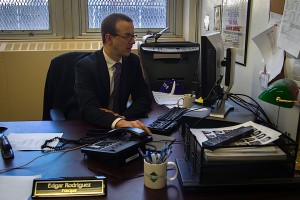This story originally appeared on GothamSchools.org.

On his first day as principal of the Academy for Careers in Television and Film in January, Edgar Rodriguez had his hands full. The two phones in his high school office rang in short, steady intervals. After a few loud rings, he picked up the one on his desk and calmed the muffled voice on the other end. Then, with a couple of strides, he was on the second phone on the opposite side of the room. “Code Blue,” he said. It was a signal for staff members who could operate a defibrillator to report to one of the school’s rooms. “Okay, great. Get everyone there.” That day, ACTvF was doing a practice drill.
For more than four years, Rodriguez had been the assistant principal of ACTvF, a Long Island City high school with 419 students. The school opened in 2008 under the leadership of founding principal Mark Dunetz, Rodriguez, and a team of staff members whose vision was to create “a non-selective high school that provided a high quality education.” They did not screen students by their academic performance. Instead they opened their doors to a diverse mix of students, many from the surrounding Queens neighborhood.
Located just south of the bustle of 36th Avenue in Queens, ACTvF aims to train students for practical careers in television and film production through in-house work and industry internships. Within a year of opening, the school was attracting more applicants than it could accommodate. Soon, students were thriving and, when the school graduated its first class last year, all of the students in it had gotten into college. The 96 percent graduation rate helped the school post the third-highest score last year on its progress report, the tool the city uses to evaluate and compare schools.
In January, Dunetz left the school he founded to join the nonprofit New Visions for Public Schools as its first vice president of school support, a promotion that made him the main contact between New Visions and the 73 city schools it supports. His departure was a testament to ACTvF’s success — but it also meant that the school faced a leadership transition that many other new schools had found difficult to overcome.
As Rodriguez stepped into the top spot, his mind was on maintaining the school’s momentum and avoiding the dip in performance that plagues many new schools undergoing a leadership change. “My goal is to make a smooth transition,” he said. “For many schools, it’s a struggle once the founding principal moves on. We want to avoid that here.”
In the last 10 years, the number of new schools exploded as the Bloomberg administration replaced large, low-performing institutions deemed to be failing. This week, speaking at ACTvF, Bloomberg highlighted the final new-school tally of his tenure: 656 schools since 2002.
Many of the new schools have already seen their principals turn over, and, within a few years of opening, many more are expected to experience leadership changes. A 2009 study by researchers at New York University and the Institute for Education and Social Policy found that after 10 years, only 16 percent of newly created New York City high schools still had their founding principals, and more than a third of new schools saw their leader change two or more times over that time. Nearly half of the newly created schools that the researchers studied lost their founding principal within the first four years.
If the trends the researchers identified remain true, hundreds of the new schools opened under the Bloomberg administration have experienced leadership transitions, or will soon experience them.
Leadership changes have caused rocky transitions, and sometimes plummeting performance, at some of the city’s new schools. One example is Brooklyn Preparatory High School, a small arts-themed school in the Greenpoint section of Brooklyn, which also underwent a rocky transition when its founding principal left in 2010. The school, which opened in 2004, saw seven teachers leave because of the leadership change, according to the school information website Insideschools. Students, parents, and teachers also reported lower satisfaction with their learning environment under new principal Noah Lansner, citing problems with school management and discipline.
Foundations Academy, a high school that opened in 2005 in the Bedford-Stuyvesant neighborhood in Brooklyn, also struggled after its first principal moved on. In 2009, the school was graduating about 70 percent of its students in four years and earned a B on its city report card under founding principal Gary Beidleman. But since Beidleman’s departure in 2011, the school’s performance data has dropped dramatically. Under current principal Jimmy Molina, the school now graduates only 26 percent of students in four years. (Exactly what caused the decline is not clear: In 2011, the city withheld the school’s annual progress report because some data could have reflected cheating.)
And Bronx Lab School was also thrust into a difficult transition when founding principal Marc Sternberg, now a deputy chancellor at the Department of Education, left the school in 2009. Under his leadership, the school graduated up to 96 percent of its seniors. In 2011, the graduation rate had dropped to just 58 percent.
Eric Nadelstern, who was a teacher, principal, superintendent, and deputy chancellor in the city’s school system for nearly 40 years, says this is a common phenomenon in new schools, whose success is often built upon the personal appeal of a passionate founding principal.
“Generally, these small schools are founded by a strong, charismatic leader,” he said from his office at Columbia University’s Teachers College, where he is a visiting professor of practice. “If you lead from the basis of your personal leadership and the strength of your charismatic personality, that’s a hard — if not impossible — act to follow.”
The lack of concrete and formal principles for guiding decision-making, evaluation, instruction, and leader selection leads some schools to struggle to bounce back after the departure of their founding principals, according to Nadelstern. Schools that succeed are often the ones that anchor their success in a common vision or mandate that is shared by teachers and goes beyond the individual principal.
Nadelstern was once himself the founding principal of a small new school. In the mid-1980s, he created the International High School in Queens, a college preparatory school for students with limited English-language abilities. He served as principal for 17 years but, when he left, the school continued to thrive and now has 14 replicas across New York City. What made the difference, according to Nadelstern, was that he was careful to prepare the school for success after his departure.
“A successful manager prepares the people they supervise for their next position,” he said. “The real issue in most schools is that principals don’t work hard enough to get commonly agreed upon processes and structures in place that everyone understands.”
Researchers studying the issue of leadership change in schools have not concluded whether leadership shifts in new schools are easier when the successor is someone from within the school, according to Alex Bowers, an associate professor of educational leadership at Columbia University.
Dunetz said he thought Rodriguez’s role as a key member of the school’s administration for the last four years gave him a huge advantage over a newcomer. When it came time to leave ACTvF, Dunetz said, he knew that Rodriguez was already respected and accepted by the rest of the school community.
But whether the new leader is an outsider or not, most schools experience a dip in performance when someone new takes over the principal’s office, according to Bowers. In most cases, he said, it takes schools two or three years to adjust to new leadership and get back to the previous levels of performance. Yet teachers, officials, parents, and students are rarely prepared for the decline and are hesitant to wait for improvement.
“It’s problematic because a part of schooling is political,” Bowers said. “Having a two-, three-, four-year horizon for performance — usually, people aren’t going to wait for that.”
As far as ACTvF is concerned, Dunetz believes the school’s structure is strong enough to withstand a leadership change without experiencing the dip in performance. He said the administration’s priority from early on was creating stability and building a school that was not dependent on the charisma of its leader. This meant instituting formal structures for how things should be done, encouraging staff engagement, and involving all administrators in decision-making.
“I’m confident it’s strong enough to keep performing at a very high level and continue to get better with time,” Dunetz said. “It’s in good hands. Otherwise I wouldn’t have left.”



